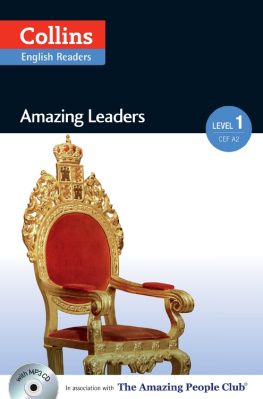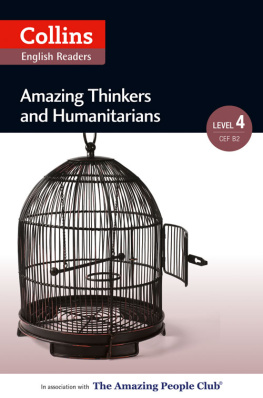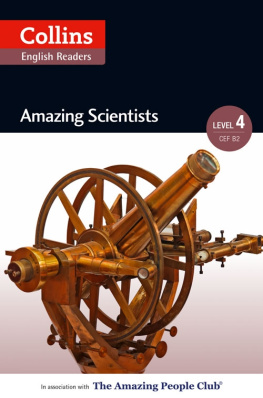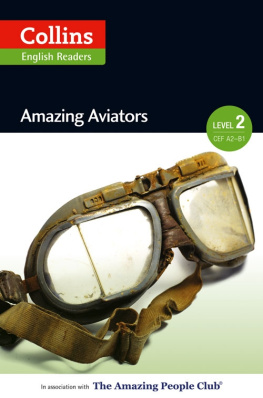You can choose to enjoy the book from start to finish or to dip into your favourite story straight away. Each story is entirely independent.
After every story a short timeline brings together the most important events in each persons life into one short report. The timeline is a useful tool for revision purposes.
Words which are above the required reading level are underlined the first time they appear in each story. All underlined words are defined in the glossary at the back of the book. Levels 1 and 2 take their definitions from the Collins COBUILD Essential English Dictionary and levels 3 and 4 from the Collins COBUILD Advanced English Dictionary.
To support both teachers and learners, additional materials are available online at www.collinselt.com/readers.

18761973
the Catalan cello-player

I had two loves in my life music and Catalonia, the place where I was born. Music was always with me, but I had to leave Catalonia because of war. I was never able to return. So my life is a story of happiness and sadness.

I was born on 29th December 1876 in El Vendrell in Catalonia into a proud Catalan family. Although my mother was born in Puerto Rico, her parents were Catalan too. Let me explain. Catalonia is the north-east region of Spain, with Barcelona as its regional capital. The Catalan people are very independent, and they have their own language and culture. Although they are part of Spain, many of them would like Catalonia to be an independent country.
My family was very musical, and music was always my first language. My father played and sang music in our local church, and he often took me with him. He gave me lessons, too, and by the age of four I could play the piano. Father was a good teacher. I gave my first public performance on the violin when I was six. It was not a completely happy experience, however, as a group of boys laughed at me because I played with my eyes closed.
Some travelling musicians visited El Vendrell one year, and they played some wonderful music. Among their instruments was a cello , which I had never heard before. Although I was only 11 I decided then that the cello was the instrument for me. Now I needed a cello teacher, so my mother took me to the Escola Municipal de Msica in Barcelona, about 70 kilometres north of El Vendrell. I studied hard, and in my free time after school and at weekends, I searched the citys music shops for interesting music. I discovered a copy of Six Suites for Solo Cello by J.S. Bach, which was like finding six bars of gold! Every day, I studied the music and played a little bit more, although I did not play Bachs Suites in public until 13 years later.
There was no television at that time, or even radio. If people wanted to hear music, they had to go to a concert hall or a caf. I played in cafs every evening, sometimes popular music and sometimes classical, and it was a very important part of my musical education. I earned money, too, which I used to pay for my teaching.
Five years later, I completed my studies at the Escola Municipal in Barcelona, but I didnt know what kind of job I could get. I continued to play in cafs, and one day a man spoke to me. He told me he had enjoyed my playing very much, and then he introduced himself. He was Isaac Albniz, a very famous pianist and composer at the time. As he was leaving the caf, he gave me a note and told me to take it to the royal palace. The palace was the home of the Queen Maria Cristina, widow of King Alfonso and mother of the future king, who was then only eight years old.
I thought he was joking, but in fact I was invited to play for Queen Maria Cristina, and she loved my music. The letter also introduced me to Count Morphy, who took an interest in my education and taught me art, philosophy and maths. With help from the Queen and the Count, I was able to study composition at the Real Conservatorio de Msica y Declamacin. I played there with the Quartet Society. That was my first proper job as a musician.

I loved playing at the palace, but I knew that I had to go abroad to have a successful career in music. I needed to meet other musicians and conductors , and play with orchestras in different cities. I moved to Paris with my mother. We had very little money, but in 1895, I found a job playing in an orchestra in a musical theatre . I had to learn French quickly. Then an offer came from Barcelona, from the Gran Teatre del Liceu. They were looking for a cellist, and I was happy to return to my home city. I did not stay long, however. The following year I joined the Madrid Symphony Orchestra, and I played solo for Queen Maria Cristina.

I developed my own style of playing, which was unlike the style of most other cellists at that time. I tried to express my emotions through the cello. People seemed to like my new style, and I was becoming known outside Spain. I was invited to England, where I played a public concert in London and a private concert for Queen Victoria, at her summer palace on the Isle of Wight. I had invitations to play in Holland, the United States and South America. In 1904, I performed for Theodore Roosevelt, the President of the United States, at the White House in Washington DC.
While I was in America, I was asked to play the piano for an opera singer, called Susan Metcalfe. We soon fell in love, but we had very little time together. We were both performers, and our concerts took us to opposite sides of the world. Because there was no time for a private life together, our relationship sadly seemed to have no future.
Two years later, in 1906, I met a young Portuguese cellist and fell in love again. Her name was Guilhermina Suggia, and she became my student. We had six wonderful musical years together, but slowly our lives began to go separate ways. Not long after my relationship with Guilhermina ended, Susan Metcalfe appeared at my dressing-room door after a performance in Berlin one evening. Susan and I fell in love all over again, and this time we married.











 C ONTENTS
C ONTENTS 


